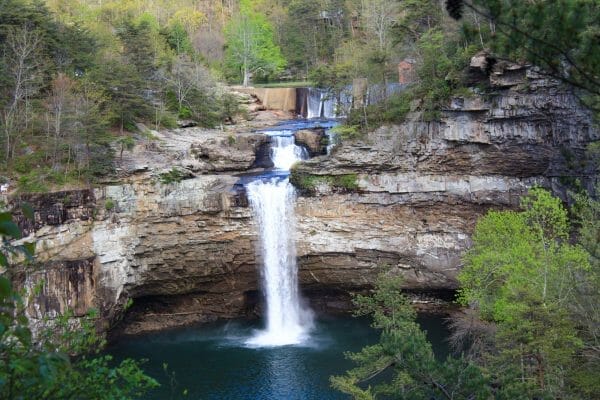Prince Madoc
Madoc (also known as Prince Madoc or Madog ab Owain Gwynedd) is a figure who appears in various versions of a legend, dating back to the sixteenth century, that center on supposed Welsh voyages to North America around 1170. According to one popular version of the legend,
 DeSoto Falls
Madoc, alleged to be a Welsh prince, landed near the site of present-day Fort Morgan on Mobile Bay and established a Welsh colony more than three centuries before Columbus’s first voyage in 1492. Additionally, the “Welsh Caves,” located beneath DeSoto Falls in Mentone, DeKalb County, contain evidence of human habitation that many of the legend’s believers claim to have been left by him and his followers. General consensus among scholars and professional archaeologists, however, rejects this and other versions of the Madoc story as highly implausible, if not impossible.
DeSoto Falls
Madoc, alleged to be a Welsh prince, landed near the site of present-day Fort Morgan on Mobile Bay and established a Welsh colony more than three centuries before Columbus’s first voyage in 1492. Additionally, the “Welsh Caves,” located beneath DeSoto Falls in Mentone, DeKalb County, contain evidence of human habitation that many of the legend’s believers claim to have been left by him and his followers. General consensus among scholars and professional archaeologists, however, rejects this and other versions of the Madoc story as highly implausible, if not impossible.
The first mention of the Madoc legend appears in a sixteenth-century manuscript by Welsh antiquarian and politician Humphrey Llwyd and was popularized after it was reproduced in historian David Powel’s 1584 history of Wales. Philosopher and astrologer John Dee and merchant and adventurer George Peckham both incorporated the Madoc story into their writings of 1580 and 1583, respectively, to justify England’s prior claim on land in the Americas. Sir Thomas Herbert later incorporated the Madoc story in his popular travel account A Relation of Some Yeares Travaile, Begunne Anno 1626 (1634), which was reprinted and sold well during the rest of the seventeenth century. Herbert’s book helped keep the idea of a pre-Columbian Welsh presence in America alive in the popular culture of British North America. Numerous reports of encounters with purported Welsh Indians occurred from the second half of the seventeenth century through the eighteenth century. The earliest reports, however, are documented much later in the eighteenth century. According to historian Bernard De Voto, over time, 13 real Native American groups, as well as five fictional tribes and three unnamed tribes, were identified as descendants of Madoc’s Welsh colonists.
The Madoc story likely began as a justification for a British empire but also promoted Welsh ethnic pride. Owain Gwynedd, the ruler of the Welsh kingdom of Gwynedd, died in 1169, leaving between 19 and 27 legitimate and illegitimate sons. A brutal civil war over succession to the throne followed. According to the legend, one of the sons, Prince Madoc, left war-torn Wales and sailed west with a shipload of his countrymen anxious for peace as well. Some writers have credited Madoc with two and possibly three voyages of settlement to the Americas. There are few specific details about the number of people and ships participating in Madoc’s supposed enterprise in any of the accounts of the legend.
Various versions of the legend claim that Madoc landed in the Americas as far south as the Amazon River and as far north as Newfoundland in Canada. The most fully developed Madoc tale, however, is set in Alabama and claims that the prince and his followers entered Mobile Bay and travelled up Alabama’s river systems to the Tennessee Valley and eastward. According to the legend, the Welsh interlopers aroused the ire of the neighboring Native American tribes and were forced to move to the area around present-day Louisville, Kentucky. Forced to move on again, the group travelled to the upper Missouri River valley and settled there. Over time, versions of the legend have expanded to include the belief that the group intermarried with the Mandan Indians who lived in the region.
The version of the legend centering on the Mobile connection was popularized by the relentlessly determined preservationist and unreliable amateur historian Hatchett Chandler and the equally unreliable
 Fort Morgan
amateur historian Zella Armstrong of Chattanooga in the book Who Discovered America? The Amazing Story of Madoc (1950). In 1953, Chandler persuaded Mobile’s Virginia Cavalier Chapter of the Daughters of the American Revolution (DAR) to erect a marker commemorating Madoc’s alleged landing at Fort Morgan in Mobile Bay. Some years later, a hurricane damaged the marker, and park officials placed it in storage. In 2007, they returned it to the DAR; it is now on display on the grounds of the chapter’s headquarters in Mobile. From 1970 to the mid-1990s, a version of the Madoc story was included in a popular textbook used in Alabama schools, but complaints from historians and other scholars led to the removal of the myth from recent editions of school textbooks. Despite professional scholars universally regarding the Madoc story as pure myth, fervent believers in a medieval Welsh presence in Alabama still continue to promote the Welsh discovery of America as authentic history. In addition to the Welsh caves, supporters of a Madoc presence in North America cite as evidence stone structures or forts in the southern Appalachian Mountains such as at Fort Mountain, Georgia as having a Welsh connection.
Fort Morgan
amateur historian Zella Armstrong of Chattanooga in the book Who Discovered America? The Amazing Story of Madoc (1950). In 1953, Chandler persuaded Mobile’s Virginia Cavalier Chapter of the Daughters of the American Revolution (DAR) to erect a marker commemorating Madoc’s alleged landing at Fort Morgan in Mobile Bay. Some years later, a hurricane damaged the marker, and park officials placed it in storage. In 2007, they returned it to the DAR; it is now on display on the grounds of the chapter’s headquarters in Mobile. From 1970 to the mid-1990s, a version of the Madoc story was included in a popular textbook used in Alabama schools, but complaints from historians and other scholars led to the removal of the myth from recent editions of school textbooks. Despite professional scholars universally regarding the Madoc story as pure myth, fervent believers in a medieval Welsh presence in Alabama still continue to promote the Welsh discovery of America as authentic history. In addition to the Welsh caves, supporters of a Madoc presence in North America cite as evidence stone structures or forts in the southern Appalachian Mountains such as at Fort Mountain, Georgia as having a Welsh connection.
Additional Resources
Armstrong, Zella. Who Discovered America? The Amazing Story of Madoc. Chattanooga, Tenn.: Lookout Publishing Company, 1950.
Deacon, Richard. Madoc and the Discovery of America. New York: George Braziller, 1967.
Fair, John D. “Hatchett Chandler and the Quest for Native Tradition at Fort Morgan.” Alabama Review 40 (July 1987): 163-98.
Fritze, Ronald H. Legend and Lore of the Americas before 1492: An Encyclopedia of Visitors, Explorers, and Immigrants. Santa Barbara, Calif.: ABC-CLIO, 1993.
Hall, John C. “Prince Madoc and the Stubborn Persistance of a Legend.” Alabama Heritage 96 (Spring 2010): 30-37.
Williams, Gwyn A. Madoc: The Making of a Myth. London: Eyre Methuen, 1979.



